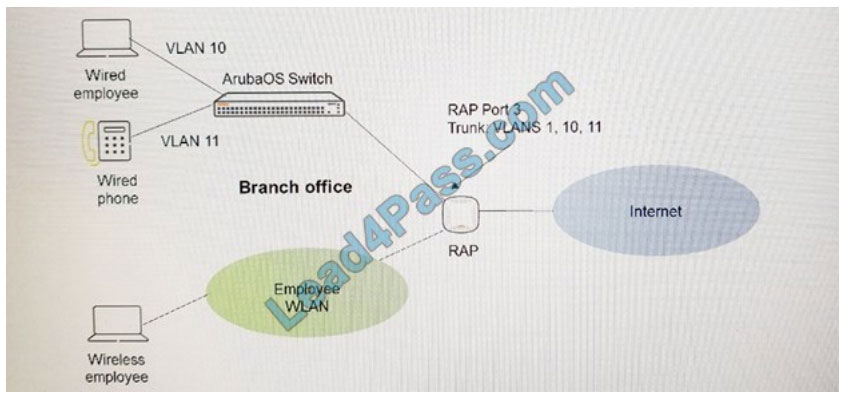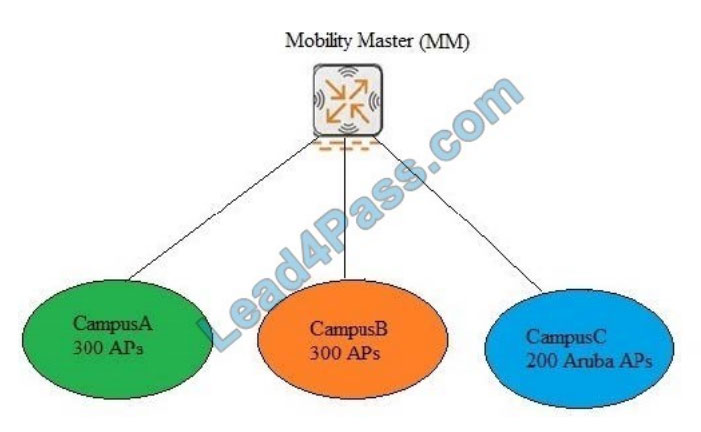
leads4pass is the provider of HP HPE6-A71 free dumps. All exam questions and answers are the latest updates. We provide 13 latest exam questions for free. The latest updated complete exam questions include 171 questions,
All exam questions and answers are the latest updates and verified by HP certified experts. leads4pass HPE6-A71 dumps come with PDF and VCE modes. You can choose between these two popular exam modes.
Click here https://www.leads4pass.com/hpe6-a71.html (PDF+VCE) to help you successfully pass the first exam.
Take the HP HPE6-A71 online exam test
The answer is announced at the end of the article
QUESTION 1
An administrator manages an AirWave Management Platform (AMP). The AMP server receives many SNMP traps from
managed devices, but no alerts are generated on the AMP for certain critical traps.
Which rule should the administrator create to cause the AMP server to generate an alert based on receipt of a critical
SNMP trap from an Aruba Mobility Controller (MC)?
A. AMON rule
B. SNMP trap rule
C. Trigger rule
D. Alert rule
QUESTION 2
An administrator wants to dynamically upgrade AppRF on Aruba Mobility Controllers (MC) in a cluster. The
administrator does not want to reboot the system at the time of the upgrade.
What should the administrator use for this upgrade?
A. Aruba image
B. Upgrade Profiles
C. Loadable Service Module (LSM)
D. Cluster Upgrade Manager
QUESTION 3
What is true about Aruba controllers under normal operations in a Mobility Master (MM)- Mobility Controller (MC)
architecture?
A. The Mobility Master can push a full configuration to a Mobility Controller.
B. ARM must be used to optimize wireless performance.
C. The APs can terminate on both Mobility Masters and Mobility Controllers.
D. Any controller can perform local configurations.
QUESTION 4
A guest establishes an authenticated wireless session to an Aruba Mobility Controller (MC). The controller uses a
ClearPass server for all AAA functions.
Which AAA component disconnects the user when the guest exceeds their allowed duration?
A. RADIUS Change of Authorization
B. Active Directory Session Limits
C. RADIUS Authorization Profile
D. SNMP Disconnect
QUESTION 5
A VIA client tries to initially connect to corporate office controller through an intermediate firewall. However, the VPN
connection fails. The administrator examines the firewall rules and determines that rules for UDP 4500 and UDP 500
are configured.
Which additional protocol must be allowed in the firewall rules to resolve this connection failure?
A. TCP 389
B. UDP 4500
C. UDP 8200
D. TCP 993
QUESTION 6
An administrator wants to implement AAA in an Aruba wireless environment that references two ClearPass servers for
redundancy. To use these servers, what must the administrator create that will be referenced in the AAA profile?
A. ClearPass Group
B. Server matching rules
C. Server Group
D. Server Load Balancing
QUESTION 7
An administrator needs to support Unified Communications and Collaboration (UCC) in a company\\’s network. The
network infrastructure requires the OpenFlow protocol to support SDN-capable applications. Which controller topology meets these requirements?
A. Zones
B. Standalone Mobility Controller
C. Mobility Master-Mobility Controller
D. Master-Local
QUESTION 8
An administrator configures a port on a RAP through the association of an AAA profile with 802.1X authentication to a
RAP Ethernet port. This port connects to a switch with user desktops attached. The administrator notices that when
users connect wirelessly to the RAP, a user role correctly restricts their traffic. But, when users connect with their wired
desktops, they are assigned an initial role and routed to a Captive Portal page.
What must the administrator do to enable desktop usage based on the user\\’s role assignment?
A. Implement ACLs on the RAP port.
B. Apply a server-derived role policy to the RAP port.
C. Identify the RAP port as untrusted.
D. Map the RAP port to an authentication profile.
QUESTION 9
An administrator enables AP load balancing for a cluster of Mobility Controllers (MCs). APs connected to the cluster
have an LMS IP address configured in their AP Group configuration. No other parameters are changed in the cluster.
If the two load AP thresholds are reached, what occurs?
A. The APs are rebalanced across the cluster.
B. The APs always stay connected to the LMS IP address configured in the AP Group profile.
C. The users are rebalanced across the cluster.
D. The users and APs are rebalanced across the cluster.
QUESTION 10
An administrator makes a configuration change on a Mobility Master (MM) that causes a Managed Controller to lose
connectivity with the MM. The MC attempts auto roll-back, but this fails.
How should the administrator recover from this problem?
A. Access the CLI of the MC and execute the no command to revert the changes.
B. Access the CLI of the MC and identify the previous configuration file the MC should use.
C. Reboot the MC to force auto-roll back to occur.
D. Access the CLI of the MC, execute the disaster-recovery command, and undo the changes.
QUESTION 11
Refer to the exhibit.

An administrator configures a policy for an AP Group. Port 3 of a RAP is a trunk that connects to a switch at a branch
office. VLAN 1 is untagged and VLANs 10 (for data) and 11 (for voice) are tagged. The administrator applies an ACL
inbound on Port 3 of the RAP.
How does this configuration affect traffic on Port 3?
A. It filters traffic from VLAN 10 and 11, but allows traffic from VLAN1.
B. It filters traffic form VLAN 1, but allows traffic from VLANs 10 and 11.
C. It allows all traffic form VLANs 1, 10, and 11.
D. It filters traffic from VLANs 1, 10, and 11.
QUESTION 12
An administrator implements the MultiZone feature and uses two clusters that utilize CPSec. A primary and a data zone
are created. MultiZone APs successfully build sessions to the primary cluster but fail to establish sessions to the data
zone cluster.
What must the administrator do to solve this problem?
A. Enable CPSec in the MultiZone profile for both the primary and data zone.
B. Enable MultiZone booting in the MultiZone AP apboot configuration mode.
C. Add the MultiZone APs to the data zone\\’s CPSec whitelist.
D. Use different AP Group names for the two zones.
QUESTION 13
Refer to the exhibit.

An administrator implements AP licensing on a Mobility Master (MM).
Network engineers at CampusA want to deploy an additional 100 APs. Currently all of the AP licenses in CampusA and
CampusB are allocated, but only 200 of the AP licenses in CampusC are allocated.
Each campus is responsible to purchase its own AP licenses. There are 900 AP licenses deployed in the global pool.
There are three dedicated pools.
From the global pool, 300 AP licenses are assigned to each dedicated pool.
What can the administrator do to add capacity for CampusA in alignment with campus policies?
A. Allow CampusA to share from the CampusC pool.
B. Add 100 more AP licenses and assign them to the CampusA pool.
C. Move 100 licenses from the CampusC pool to the global pool.
D. Add 100 more AP licenses to the global pool.
Verify the answer:
| Q1 | Q2 | Q3 | Q4 | Q5 | Q6 | Q7 | Q8 | Q9 | Q10 | Q11 | Q12 | Q13 |
| C | C | A | A | B | C | C | C | D | D | D | C | C |
HP HPE6-A71 exam PDF free download
Google Drive: https://drive.google.com/file/d/1jAhw5mobGNcc0GlbjeDwkCarzeCt2IPQ/view?usp=sharing
The above free HP HPE6-A71 exam questions can help you improve your exam skills. leads4pass provides the latest updated 171 exam questions, get the complete HP HPE6-A71 exam dumps https://www.leads4pass.com/hpe6-a71.html(Total Questions: 171 Q&A) Pass the exam successfully.